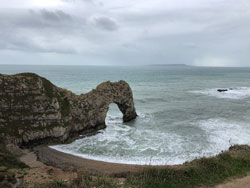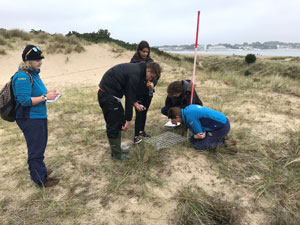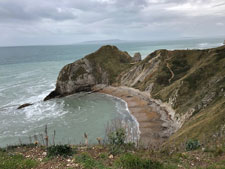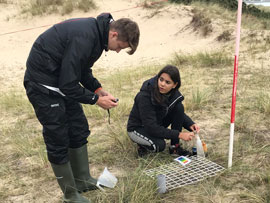A level Geography students discover coastal landforms
Osmington Bay just outside of Weymouth was the base for our A level Geography students who would be collecting data along the world-famous Jurassic Coast. The aim of the weekend was twofold. The first being to look at actual coastal landforms live and for students to collect the data which will allow them to complete their non-examined assessment (NEA), more commonly known as coursework.
 After an introduction talk outlining the aims of the weekend, the group set off for our first session at Durdle Door and Lulworth Cove. With the help of the field centre staff the group looked at the two geographical landforms and saw how erosional and depositional processes linked with both geology and subaerial processes have led to what is there today. The weather was quite windy, and the seas were quite rough which gave the students an appreciation of how powerful waves can be and how this affects that rate of erosion. This is important to the students because in their exam they will need to be able to describe and explain how both erosional landforms are created and able to give located examples.
After an introduction talk outlining the aims of the weekend, the group set off for our first session at Durdle Door and Lulworth Cove. With the help of the field centre staff the group looked at the two geographical landforms and saw how erosional and depositional processes linked with both geology and subaerial processes have led to what is there today. The weather was quite windy, and the seas were quite rough which gave the students an appreciation of how powerful waves can be and how this affects that rate of erosion. This is important to the students because in their exam they will need to be able to describe and explain how both erosional landforms are created and able to give located examples.
 In the evening session, the students then focused on the next day which we would be at Shell Bay, carrying out fieldwork on the origin and development of a psammosere or sand dune. Sand dune succession was the part of the specification that the students were going to investigate. Sand dune succession looks at how the sand dunes are formed by aelionian deposition and then how plants and animals affect the development of sand dune. The students had already decided on what data they were going to collect but we needed to finalise the method of how we are going to collect the data. This is important to the students because part of the NEA assessment is on the students’ methodology and the more robust and consistent this is the more reliable results they will achieve. The students had decided to collect data on pH, height change, infiltration rates, wind speed, plant coverage and species diversity.
In the evening session, the students then focused on the next day which we would be at Shell Bay, carrying out fieldwork on the origin and development of a psammosere or sand dune. Sand dune succession was the part of the specification that the students were going to investigate. Sand dune succession looks at how the sand dunes are formed by aelionian deposition and then how plants and animals affect the development of sand dune. The students had already decided on what data they were going to collect but we needed to finalise the method of how we are going to collect the data. This is important to the students because part of the NEA assessment is on the students’ methodology and the more robust and consistent this is the more reliable results they will achieve. The students had decided to collect data on pH, height change, infiltration rates, wind speed, plant coverage and species diversity.
 We arrived at Shell Bay on a grey Saturday morning ready for a day of data collection. The weather was a slight concern leading up to the weekend, but thankfully no rain was forecast. Once the group arrived at the data collection site, we finally agreed our sampling strategy: we were going to complete 3 transects which were 20m apart and 120m in length from the front of the beach inland. The students were taught how to collect the data and the different methods were split up to allow the data to be collected in a consistent manner. Once the group mastered the methods they worked as a well-oiled machine and collected the data in a very ordered, thorough manner. Over the day the students collected 100 pieces of data. Our geographers travelled back to the centre knowing they had collected the data which would allow them to complete their NEAs. However, the day was not finished, and the students returned to the classroom in the evening to transfer their data onto computers to allow them to anaylse their results. The students looked at which graphs they could use to present the data and which statistical tests they could also use to analyse their results further. The students returned to their rooms knowing that they had completed a very productive day and were returning home with all the data needed to complete their NEAs.
We arrived at Shell Bay on a grey Saturday morning ready for a day of data collection. The weather was a slight concern leading up to the weekend, but thankfully no rain was forecast. Once the group arrived at the data collection site, we finally agreed our sampling strategy: we were going to complete 3 transects which were 20m apart and 120m in length from the front of the beach inland. The students were taught how to collect the data and the different methods were split up to allow the data to be collected in a consistent manner. Once the group mastered the methods they worked as a well-oiled machine and collected the data in a very ordered, thorough manner. Over the day the students collected 100 pieces of data. Our geographers travelled back to the centre knowing they had collected the data which would allow them to complete their NEAs. However, the day was not finished, and the students returned to the classroom in the evening to transfer their data onto computers to allow them to anaylse their results. The students looked at which graphs they could use to present the data and which statistical tests they could also use to analyse their results further. The students returned to their rooms knowing that they had completed a very productive day and were returning home with all the data needed to complete their NEAs.
 On Sunday morning the group travelled into Weymouth to look at how regeneration had affected different areas of the town including the pavilion, Brewers Quay and the town centre. The group also learnt about the history of Weymouth and how it has developed into what it is today. This would again provide an extra case study for the students to use in their exams. The students looked at the effects the 2012 Olympics had on these areas as Weymouth hosted the sailing events.
On Sunday morning the group travelled into Weymouth to look at how regeneration had affected different areas of the town including the pavilion, Brewers Quay and the town centre. The group also learnt about the history of Weymouth and how it has developed into what it is today. This would again provide an extra case study for the students to use in their exams. The students looked at the effects the 2012 Olympics had on these areas as Weymouth hosted the sailing events.
Our students returned to Cambridge following a very productive weekend. All the students worked extremely hard and were ready to tackle the task of completing the 3000-4000 document which is worth 20% of the students’ overall grade.

